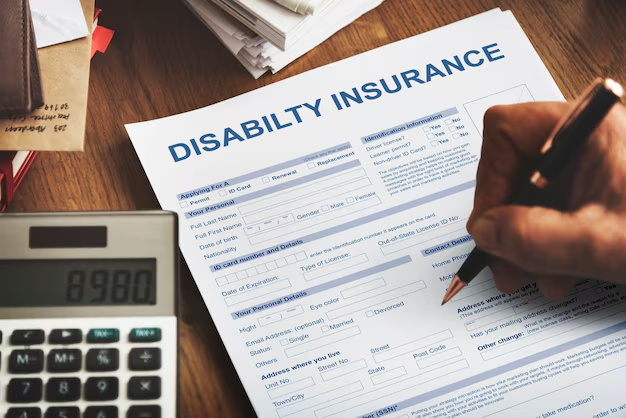In an unpredictable world, where accidents and illnesses can strike at any time, ensuring financial security is essential. While most people are accustomed to traditional health insurance and life insurance, disability insurance is often overlooked, despite its crucial role in protecting income when you’re unable to work due to a disability. This comprehensive guide will explore what disability insurance is, how it works, its types, and why it’s a critical safety net for many individuals, especially those who rely on their income to support themselves and their families.
What Is Disability Insurance?
Disability insurance is a type of insurance that provides income replacement to individuals who are unable to work due to a disability. Disabilities can arise from various causes such as accidents, chronic illnesses, or severe medical conditions, and when these events prevent an individual from performing their job duties, disability insurance helps to offset the loss of income. The key purpose of disability insurance is to provide financial support so that the policyholder can continue to meet living expenses and obligations while they recover or adjust to their condition.
Unlike health insurance, which covers medical expenses, disability insurance focuses on replacing a portion of lost income. It ensures that the individual does not face financial hardship when they are unable to work due to health reasons. Disability insurance is vital for those who depend on their regular paycheck for basic needs, such as paying bills, covering rent or mortgage payments, or taking care of family responsibilities.
Key Takeaways
- Disability insurance provides income replacement if you are unable to work due to an illness or injury.
- There are two primary types: short-term (provides coverage for a few months) and long-term (covers extended periods, possibly until retirement).
- Disability insurance typically covers 50-70% of your income, helping you maintain financial stability.
- Policies vary in terms of premiums, coverage, and waiting periods, so it’s essential to choose the right plan for your needs.
- It’s especially important for self-employed individuals, those with high-income professions, and parents or caregivers who rely on their paycheck to support their families.
Disability insurance is an essential financial tool to help you weather unexpected challenges and maintain a stable income in times of hardship.
How Does Disability Insurance Work?
Disability insurance operates by providing a financial benefit for a specific period if you become temporarily or permanently disabled and are unable to work. The benefit amount is usually a percentage of your regular income (typically between 50% to 70%) and is paid monthly, depending on the policy’s terms.
Here’s a breakdown of how disability insurance works:
- Purchasing a Policy: You first need to purchase a disability insurance policy. The terms, coverage, and premiums vary based on factors such as your age, occupation, income level, and health status. You can purchase either short-term or long-term disability insurance, depending on your needs.
- Paying Premiums: Similar to other types of insurance, you must pay premiums for your disability insurance. Premiums can be paid monthly, quarterly, or annually. The premium amount is influenced by factors like the type of coverage, the benefit amount, the elimination period (time before the benefits begin), and the length of the benefit period.
- Filing a Claim: If you become disabled and cannot work, you will need to file a claim with your insurance provider. Depending on your policy, you may need to submit medical documentation from your healthcare provider or undergo an evaluation to confirm the extent of your disability.
- Elimination Period: After filing a claim, you typically need to wait a certain period before benefits kick in. This waiting period is known as the elimination period. It can range from a few days to several months, depending on your policy. Short-term disability policies usually have a shorter elimination period compared to long-term disability policies.
- Receiving Benefits: Once approved, you will start receiving benefits according to the terms of your policy. The benefit typically replaces a percentage of your pre-disability income, and this replacement can continue for a specific duration, which can vary based on whether you have short-term or long-term disability insurance.
- Rehabilitation and Return to Work: If your disability is temporary, you may eventually return to work. Some policies offer vocational rehabilitation benefits to help individuals with training or resources to return to work, either in their previous role or a different capacity. If you’re permanently disabled, the benefits may last for as long as you are unable to work or for the rest of your life, depending on the terms of your policy.
Types of Disability Insurance
Disability insurance can be broadly categorized into two main types: short-term disability (STD) and long-term disability (LTD). Both types provide essential income replacement but differ in the duration of coverage and the severity of the disability.
Short-Term Disability Insurance (STD)
Short-term disability insurance provides income replacement for a limited period (typically 3 to 6 months) if you become temporarily disabled. It usually covers a higher percentage of your salary, often up to 60-70%, but the benefits are only available for a short duration. Short-term disability insurance is often used for temporary illnesses or injuries that prevent an individual from working, such as recovery from surgery or childbirth.
Key features of STD:
- Duration of coverage: A few weeks to 6 months
- Benefit amount: 60-70% of income
- Elimination period: Usually short, ranging from 0 to 14 days
Long-Term Disability Insurance (LTD)
Long-term disability insurance kicks in after short-term disability benefits end and can last for several years or even until retirement age, depending on the policy. LTD insurance is intended for individuals who experience long-lasting or permanent disabilities. While the monthly benefit is typically a smaller percentage of your income (usually 50-60%), it can continue for years or until you reach a specific age, such as 65 or 67.
Key features of LTD:
- Duration of coverage: Several months to years, or until retirement age
- Benefit amount: 50-60% of income
- Elimination period: Longer, often 90 days to 180 days
Key Terms in Disability Insurance

When choosing a disability insurance policy, it’s essential to understand some of the key terms associated with these types of policies:
- Benefit Period: The length of time you can receive disability benefits once you’ve been approved. It can range from a few months (for STD) to several years or until retirement (for LTD).
- Elimination Period (Waiting Period): The waiting period before you start receiving disability benefits. It usually ranges from a few days to several months. Short-term policies have a shorter elimination period compared to long-term policies.
- Own Occupation vs. Any Occupation: Some policies cover disabilities that prevent you from doing your current job (own occupation), while others may only provide benefits if you cannot perform any job (any occupation). “Own occupation” policies are generally more favorable for professionals in specialized roles.
- Partial Disability: This refers to situations where you’re partially unable to work due to a disability but can still perform some job functions. Some policies offer partial disability benefits to cover the loss of income from reduced hours or responsibilities.
- Residual Benefits: These benefits cover a percentage of lost income if you can still work part-time or in a limited capacity but suffer a reduction in earning potential due to your disability.
Why Disability Insurance Is Important
Many people rely on their income to maintain their lifestyle, pay bills, and support their families. However, the risk of being unable to work due to an illness or injury is very real. According to the Social Security Administration (SSA), approximately one in four of today’s 20-year-olds will become disabled before they reach retirement age. Disability insurance offers peace of mind, knowing that if something were to happen, there would be a financial safety net in place.
Disability insurance is particularly critical for:
- Self-employed individuals: Those who don’t have access to employer-sponsored disability insurance.
- High-income earners: Professionals like doctors, lawyers, and executives who may have a higher income to protect.
- Parents and caregivers: Individuals who are responsible for their families’ financial well-being.
- Blue-collar workers: People in physically demanding jobs, who may be more vulnerable to disabling accidents and injuries.
Without disability insurance, a sudden accident or illness can lead to severe financial hardship, especially for those living paycheck to paycheck. It’s important to ensure that you have adequate coverage to protect your income and financial future.
Also Read : What Types Of Business Insurance Do Small Businesses Need?
Conclusion
Disability insurance is a crucial safety net that ensures you don’t face financial ruin if you become unable to work due to illness or injury. Whether you opt for short-term or long-term coverage, having disability insurance provides peace of mind and protects your financial future. With the high likelihood of suffering a disabling condition at some point in life, it’s vital to plan ahead and consider the benefits of disability coverage as part of your overall financial strategy.
FAQS
What’s the difference between short-term and long-term disability insurance?
Short-term disability insurance provides income replacement for a few months, typically up to six months. Long-term disability insurance provides coverage for extended periods, often until retirement age, and is meant for more serious or permanent disabilities.
How much disability insurance do I need?
The amount of disability insurance you need depends on your income and expenses. Most policies provide 50% to 70% of your pre-disability income, which is usually enough to cover living expenses, but you may need additional coverage if you have significant financial obligations.
Can I get disability insurance if I already have a health condition?
You can get disability insurance with an existing health condition, but it may be more expensive, or certain conditions may be excluded from coverage. This is called a pre-existing condition exclusion, and it’s essential to discuss your health history with your insurance provider.
What happens if I recover from my disability and can return to work?
If you recover and return to work before the benefit period ends, your disability insurance benefits will stop. Some policies may offer a “return-to-work” program that helps you transition back to your job, possibly providing partial benefits during your gradual return.
Is disability insurance tax-free?
Disability insurance benefits may or may not be taxable, depending on how the premiums were paid. If you paid premiums with after-tax dollars, your benefits will typically be tax-free. However, if your employer paid the premiums and you didn’t pay taxes on them, the benefits may be taxable.
How do I apply for disability insurance?
You can apply for disability insurance through an insurance broker or directly with an insurance company. You’ll need to provide personal details, income information, and medical history to get a quote and determine eligibility.
Can I purchase disability insurance if I’m self-employed?
Yes, self-employed individuals can purchase disability insurance to protect their income. In fact, it’s especially important for self-employed people who don’t have employer-sponsored coverage.
